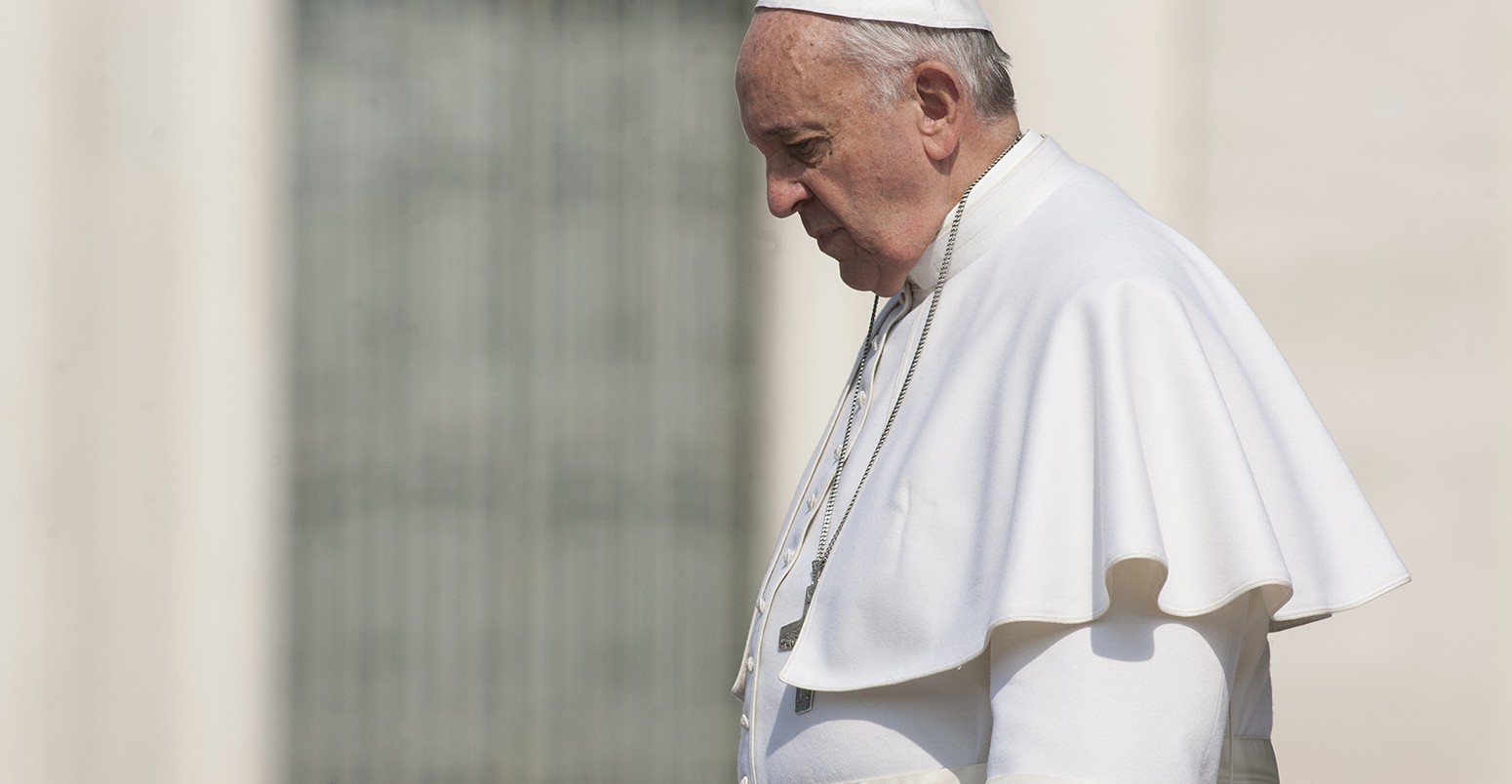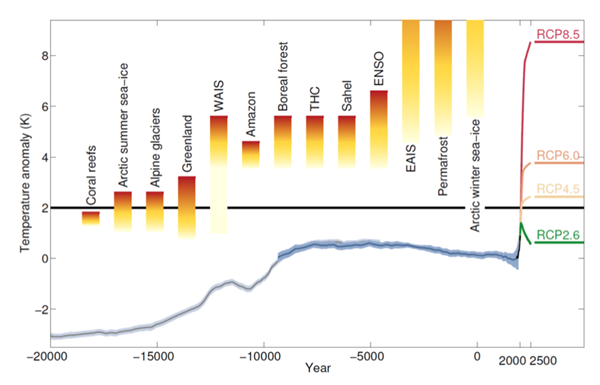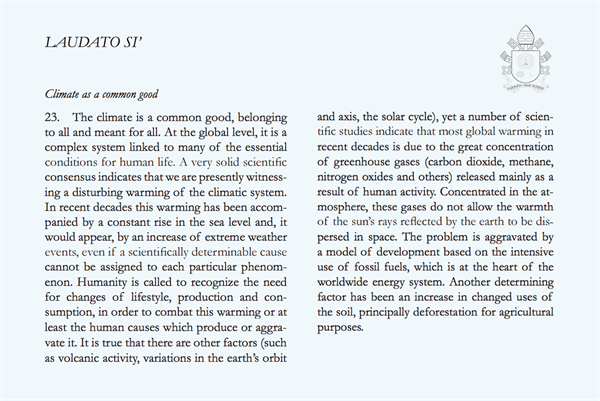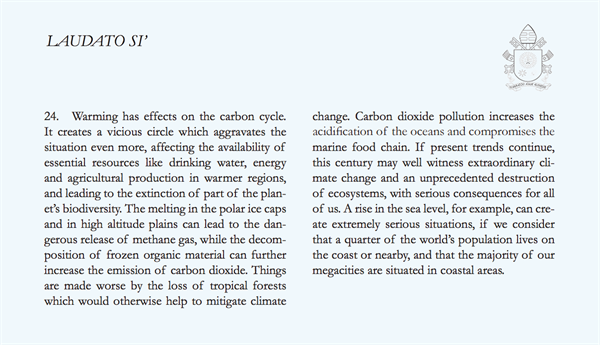
In-depth: the science behind the papal encyclical
Sophie Yeo
06.19.15Pope Francis attempted to start a global conversation yesterday with his new encyclical on the environment. Unlike most encyclicals, it was addressed not to Catholics, but to “every person living on this planet”.
There was one group, however, that received particular attention: scientists. For a select number, including climatologists, botanists, and oceanographers, the conversation began long before the Vatican presented its much-anticipated document in Rome yesterday.
Their influence can be found throughout the 184-page document, which some had speculated could be filled with theological obscurities rather than an empirical call to action on climate change.
They needn’t have worried. The apostolic exhortations and catechisms were relegated to second place behind the Pope’s concerns about melting ice caps, methane gas and carbon credits.
History
This content is the result of more than a year of consultation between Pope Francis and academics.
But the seeds of the idea were planted long before. Back in 1990, before the UN had set up a body dedicated to climate change, Pope John Paul II was urging Catholics to take care of their natural environment.
His successor, Pope Benedict XVI, was nicknamed the first “green pope” due to his exhortations to protect the natural world and his own efforts to cut carbon emissions, including purchasing carbon credits and installing solar panels, making the Vatican the first fully carbon neutral country.
Under his watch, the Pontifical Council for Justice and Peace released the “Ten Commandments of the Environment” in 2005, while another of its academic bodies held a workshop on the retreat of mountain glaciers in 2011.
Ottmar Edenhofer, chief economist at the Potsdam Institute for Climate Impact Research, says that a Vatican City project initiated under Benedict fed into the encyclical released yesterday. He tells Carbon Brief:
This resulted in a book published in 2012, linking climate change, justice and sustainability.
Under Pope Francis, Edenhofer was called to the Vatican City in his capacity as co-chair of the Intergovernmental Panel on Climate Change (IPCC) report on mitigation – the third in the series of UN-backed compilations of the latest science released between 2013 and 2014. He says:
The Vatican itself has two scientific bodies, which have been involved more than any other in constructing the encyclical. These are the Pontifical Academy of Sciences and the Pontifical Academy of Social Sciences.
These two bodies contain academics from around the world, who are handpicked as life members, regardless of their religion. Their job is to produce reports on the science and report back to the Vatican’s hierarchy.
“They’re always recorded and the Pope directly or through his advisors looks at everything we conclude,” says Peter Raven, president emeritus of the Missouri Botanical Gardens, and member of the Pontifical Academy of Sciences since 1990, speaking to Carbon Brief.
In May 2014, the two bodies held a workshop covering a spectrum of climate change-related topics, from food production and the ocean to megacities and tropical forests. It was these discussions that prompted the writing of the encyclical “in earnest”, says Raven.
But Pope Francis has gone “several steps further” than his predecessors by highlighting the ethical dimensions of climate change, Raven adds. The encyclical is as much as scientific document as it is an appeal for global justice, rooted in care for the natural world. He says:
The scientific pope
Thanks to the personal involvement of Francis, who himself once worked as a chemist in Argentina, the scientists’ stamp appears throughout the document.
Cardinal Turkson, president of the Pontifical Council for Peace and Justice, wrote the first draft, with Francis steering it into its final shape, taking a week in March to finesse the final edition.
Along the way, he also met with scientists of the Pontifical Academy of Sciences so they could present their reports to him (“He’s every bit as charismatic and attractive and wonderful a person as implied,” says Raven).
The Vatican held another conference on 28 April this year, by which time the encyclical was largely finished, giving Francis and UN secretary general Ban Ki-moon an opportunity to converse about climate change on the sidelines, as well as gather more insight from scientists.
This is also where the Pontifical Academies released their own report, “Climate change and the common good: a statement of the problem and the demand for transformative solutions”, specifically designed to support Pope Francis’ work.
This process of consultation comes into fruition in paragraphs 23 and 24 of the encyclical. In precise language, free from the language of religion, Francis sets out the causes of climate change and its impacts.
This is not the only place where the Pope gets into the detail of climate change. He shows himself to be plugged into various topics, including, for example, the economy:
Renewable energy:
International policy:
And the fossil fuel industry:
Scientific input
None of the scientists involved in the process approached by Carbon Brief could point to exactly how or where their input was incorporated. Astronomer Royal Professor Martin Rees, appointed to the Pontifical Academy of Sciences in 1990, tells Carbon Brief:
Yet the similarity between the encyclical and the supporting information produced by the scientists is evident.
The statement produced by scientists and economists at the May 2014 meeting speaks about the “technological and operational bases” for sustainable development and focuses on the “growing gap between the rich and the poor within and between nations”. Like the encyclical, it looks at the impact of industrial agriculture on ecosystems.
Meanwhile, the report of the Pontifical Academies called for “near-zero carbon emissions by around 2070”, which would mean rapidly replacing fossil fuels with renewable energy, as the Pope recommends – although there was some ambiguity about this demand, and the precise wording is not repeated in the encyclical.
At the request of the Vatican, Professor Hans Joachim Schellnhuber, the director of the Potsdam Institute, who was also heavily involved in the scientific background to the encyclical, wrote a report to accompany its release.
The institute tells Carbon Brief that it represents a “compilation” of his scientific work and thinking on climate change. It covers topics such as possible solutions to the problem, and the graduated impacts of failing to prevent it, as the graph below shows.

Graph showing the temperature at which climatic “tipping points” set in. Blue/grey line shows temperature so far, with Representative Concentration Pathways (RCPs) indicating scenarios based on future emissions levels. Source: Common Ground, Hans Joachim Schellnhuber.
Global commons
But the most important element of the encyclical is where science and morality merge in the presentation of the atmosphere as a “global commons”, says Edenhofer.
In paragraph 174, the Pope writes:
As shown in the text box above, this would mean treating the atmosphere as the common property of mankind and regulating it accordingly, rather than allowing it to be freely accessible to whoever wants to, without penalty, pollute it. Edenhofer says:
Schellnhuber’s report to support the encyclical examines the scientific and policy implications of turning the atmosphere into a “global commons”. He says:
Limits of science
The encyclical is a case of the Pope doing what science cannot.
Last year in Berlin, government representative met to approve, line-by-line, the “ summary for policymakers” of the IPCC’s working group 3 report. As co-chair, Edenhofer watched on as delegates from countries as diverse as the US, Tanzania, Canada, South Sudan and France objected to the inclusion of the phase “global commons” in the IPCC’s summary document, which is forwarded to governments around the world.
Their concern was that this could be seen as a political statement in what is supposed to be a policy-neutral document. The idea of the “global commons” was eventually relegated to a footnote, which stresses that it “has no specific implications for legal arrangements”.
According to Raven, the genesis of the encyclical lay in the frustration of scientists about the near-stagnant efforts to tackle climate change, compared to the urgency of their own research. This is what makes the encyclical even more powerful than the IPCC, he tells Carbon Brief.
The fact that the Pope has done a “pretty balanced job” of incorporating the input of scientists reinforces the authority of the encyclical, says astronomer Rees. He tells Carbon Brief:
Partha Dasgupta, emeritus professor at the University of Cambridge, who has been a key player in the scientific events leading up to the encyclical, praised the Pope’s treatment of economics. He tells Carbon Brief:
However, Edenhofer stresses that “we should not perceive this encyclical as a kind of substitute for an IPCC document”. He says it is “complementary”, adding:
Policy
In Paris this December, world leaders will meet to sign a new UN treaty aimed at regulating greenhouse gas emissions and dealing with the impacts of climate change.
From discussions to date, it seems likely that much of the debate will centre around how much each country should rein in its emissions, essentially making a personal effort for the global good.
The conversation may have started in the language of science, but the morality of the message will be heard across all the countries of the world, including the diplomats on whom the burden of action now falls.
With 1.2 billion Catholics in the world, the Pope’s message is expected to reverberate far beyond the Vatican (which doesn’t count as a country at the UN). Raven says:



